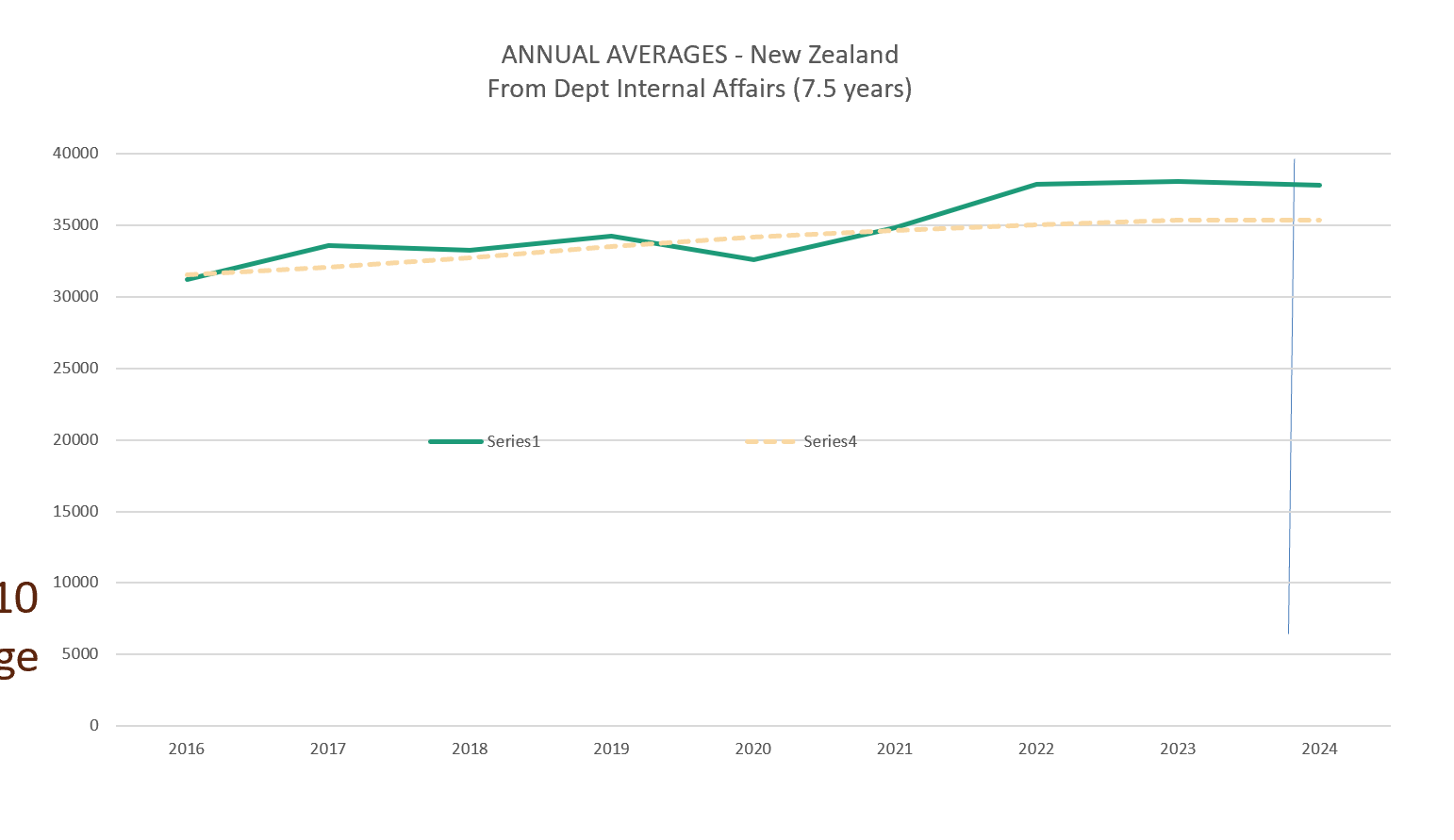Mark Freeman
A funeral director has observed regional variations in death numbers in New Zealand since the rollout of the Covid-19 vaccine. He has also anecdotally noticed increases in the numbers of ‘turbo deaths’.
The funeral director, who wants to remain anonymous, has collected quarterly death statistics directly from the Department of Internal Affairs (DIA) since late 2019. The raw data from the DIA are not publicly available. The DIA also gives its data to Stats NZ, which interprets the data as it chooses, he says. Stats NZ is the source of the official deaths data found on the internet.
In spite of the Covid vaccine being rolled out in the second half of 2021, the funeral director says the death numbers for that year were close to normal. The numbers jumped in 2022 (see graph).
In 2023, according to the DIA, the nationwide excess death rate was 13.9 per cent. In other words, the death rate (the number of deaths as a proportion of the population) in 2023 was nearly 14 per cent higher than the death rate for the seven years pre-Covid. The excess death rate appears to be tracking down slightly for the first two quarters of 2024, the funeral director says. He predicts the excess death rate for the whole of 2024 will be 10–12 per cent.
Graph: Annual death numbers in New Zealand 2016-2024

Note: The continuous line represents the actual numbers of deaths in New Zealand 2016–2023. The dashed line represents the expected numbers of deaths, taking into account population growth.
Regional breakdowns of death numbers show contrasts (see table below). Comparing 2021 with 2023, there was a 44.8 per cent increase in deaths registered in Wellington City. Nelson had a 29.7 per cent increase, while North Shore’s increase was 26.6 per cent and Palmerston North’s 24.4 per cent.
These figures do not take into account population growth, which nationally is about one per cent per year. “Not knowing the actual increase in population for the regions means there could be a two to five per cent margin for error but, even with this, it is frightening,” says the funeral director.
It’s unclear why there are dramatic increases in death numbers in some cities. One possible reason is that some people who live in outlying small towns and rural areas may be dying in the hospitals in the nearby cities – where their deaths are registered.
One region where the contrast is particularly noticeable is Wellington. While death numbers in Wellington City increased sharply, deaths in other parts of the Wellington region fell. Comparing 2021 and 2023, the annual death number in Porirua dropped by 50.9 per cent, Kapiti was down by 14.0 per cent and Lower Hutt was down by 13.8 per cent. When the figures for those three areas are combined with Wellington City’s, the death numbers for the whole Wellington region were up by 2.9 per cent.
The funeral director questions why the death numbers for Porirua, Kapiti and Lower Hutt are so low. “Is it because the Wellington region is where many government workers live, and where many workers were given exemptions from Covid vaccination and possibly many others were given placebos?” Many government workers may live outside the city, he speculates. Another factor underlying the contrast could be that some people who live in the Wellington region but outside Wellington City are dying in Wellington Hospital, leading to increased death numbers for Wellington City.
The table shows the number of deaths in cities and larger towns for the years 2020–2023. The numbers for 2021 and 2023 are compared.
Table: Annual death numbers in New Zealand by (larger) centre 2020-2023
|
|
2020 |
2021 |
2022 |
2023 |
Comparison |
|
Auckland City |
6972 |
7552 |
8232 |
8230 |
+9.0% |
|
Blenheim |
415 |
462 |
446 |
473 |
-1.9% |
|
Christchurch |
3460 |
3615 |
4007 |
4115 |
+13.8% |
|
Dunedin |
885 |
908 |
954 |
979 |
+7.8% |
|
Gisborne |
380 |
372 |
426 |
403 |
+8.3% |
|
Hamilton |
1751 |
1810 |
1941 |
2070 |
+14.4% |
|
Hastings |
266 |
371 |
413 |
404 |
+8.9% |
|
Invercargill |
728 |
730 |
770 |
797 |
+9.2% |
|
Kapiti |
480 |
515 |
491 |
443 |
-14.0% |
|
Levin |
431 |
490 |
480 |
489 |
-0.02% |
|
Lower Hutt |
830 |
908 |
859 |
851 |
-13.8% |
|
Napier |
658 |
675 |
758 |
715 |
+5.9% |
|
Nelson |
607 |
666 |
807 |
864 |
+29.7% |
|
New Plymouth |
737 |
765 |
795 |
787 |
+2.9% |
|
North Shore |
132 |
361 |
251 |
457 |
+26.6% |
|
Palmerston Nth |
858 |
902 |
966 |
1132 |
+24.4% |
|
Porirua |
504 |
555 |
494 |
272 |
-50.9% |
|
Rotorua |
604 |
604 |
724 |
687 |
+13.7% |
|
Tauranga |
1372 |
1615 |
1832 |
1691 |
+4.7% |
|
Waitakere |
1028 |
1071 |
1207 |
1212 |
+13.2% |
|
Wellington City |
961 |
1123 |
1357 |
1626 |
+44.8% |
|
Whakatane |
453 |
516 |
537 |
540 |
+4.7% |
|
Whangarei |
871 |
1013 |
1189 |
1134 |
+11.9% |
Source: Raw data from the Department of Internal Affairs.
The funeral director believes the current excess death rate in New Zealand will become the ‘new normal’. “Give it a few years and they’ll say that’s the normal death rate because it will become normal.”
Turbo deaths
Many funeral directors that he knows, even those not previously ‘awake’, are often shocked at the increases in death rates and the increase in ‘turbo deaths’.
Before Covid, he says, funeral directors rarely saw people in their 50s dying and then often only after a long illness. “Since Covid, across the industry, it has become commonplace, almost weekly, to look after deaths of people in their 50s.”
“They tend to be turbo cancers. They’re all short-term illnesses. Most seemed to get diagnosed within six to eight weeks – and some shorter – from death. In pre-Covid days, people would get diagnosed, they’d go through treatment and they’d go into remission. They’d have three or four more years.”
Major changes in death rituals
The funeral director has also noticed major changes connected with death rituals since Covid.
There has been “a real culture change” in embalming practices. Most families have not been embalming the bodies of their loved ones since the peak of Covid, when the government temporarily banned the practice. Before Covid, 80 per cent of bodies would be embalmed; now it’s 30 per cent or lower in some areas, he says.
Another change is an increase in the number of mental health problems related to deaths. The number is currently “going through the roof”, partly because some families are not holding funerals for their loved ones.
For thousands and thousands of years, every culture around the world has had rituals to say goodbye, he says. “A funeral’s not the be-all-and-end-all, but it’s the beginning of the process of saying goodbye. It’s like the kick-start. If you don’t start, you can’t even journey.”









